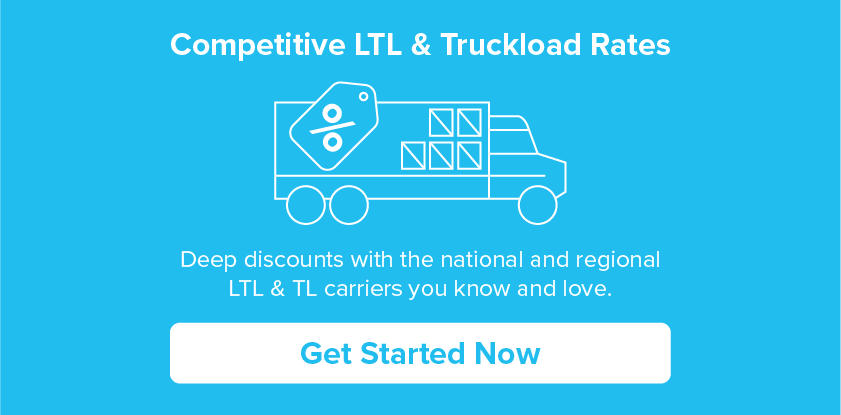One of the primary goals of supply chain management is to ensure the seamless flow of goods from suppliers to companies to consumers. Freight in and freight out play a pivotal role in this process.
Freight in and freight out are occasionally used interchangeably but there are critical distinctions between the two—and understanding how they differ (and the nuances of each) is essential to controlling costs while also meeting ever-growing consumer demands and staying a step ahead of your competition.
Let’s explore freight in vs freight out in more detail and see how this pillar of freight management forms the foundation of your business.
Overview of Freight Management's Dual Aspects
Freight management, or the strategic act of transporting goods from their point of origin to their ultimate destination, depends on the efficiency of inbound and outbound freight practices:
- Freight in – Freight in, or inbound freight, refers to the delivery of merchandise or raw materials to a facility for production, as well as the costs incurred in the process.
- Freight out – By contrast, freight out (or outbound freight) is shorthand for the process and shipping expenses incurred by sellers to deliver finished products to their customers or distribution channels.
Gaining a solid grasp of both of these concepts and what they entail is crucial to optimizing efficiency, reducing freight costs, and maximizing your bottom line.
Understanding Freight In (Inbound Freight)
To reiterate, inbound freight describes the incoming supplies your business receives to create your product and the costs involved in transport—what’s frequently referred to as a business-to-business (B2B) transaction. It’s deemed a direct, recurring expense that makes your daily business operations possible.
Yet, it’s not just a matter of receiving the supplies you need. Freight in also encompasses:
- Ordering
- Delivery
- Storage
- Inventory control
The punctual delivery of your products, and the quality of your products, rely on a sound inbound freight plan.
Characteristics and Strategic Value
Think of inbound freight as the what, how much, and when. These deliveries keep your shelves stocked and production lines moving without hiccups. Timely and accurate inbound freight supports your business goals by keeping everything running on schedule and avoiding costly delays.
Cost Management and Efficiency
Cutting inbound logistics costs is a common and understandable aim for businesses. Tactics may include:
- Negotiating with suppliers for better freight rates
- Finding the most efficient delivery routes
- Putting together larger shipments to save on transport
- Monitoring inventory to avoid urgent, last-minute deliveries (and to prevent spoilage in raw materials)
These strategies help optimize your supply chain costs and efficiency.
Exploring Freight Out (Outbound Freight)
Also referred to as ‘delivery expenses,’ freight out is, put simply, the process and costs of delivering goods to your endpoint customer or distribution channel after a sale has been made and the product is ready for shipment.
Key Features and Operational Impact
Whereas freight in manages storage, outbound freight involves how goods are selected, packaged, labeled, and shipped. This phase directly influences customer satisfaction because it addresses delivery requirements and the complexities of last-mile logistics.
Efficient outbound freight means:
- On-time deliveries and fewer problems
- Meeting customer demand
- Building trust in your brand
- Monitoring changes in shipment costs
- Appropriately pricing products to reflect freight in charges
An effective outbound freight plan also emphasizes reducing costs—a topic we’ll turn to next.
Strategies for Cost Reduction and Optimization
Decreasing expenses in outbound logistics leans on strategic actions such as:
- Optimizing delivery routes
- Choosing reliable carriers
- Employing advanced technology for more efficient logistics planning
These measures can both boost your bottom line and mitigate disruptions on the path from your production center to your customer.
Comparative Analysis: Freight In vs. Freight Out
Freight in and freight out each serve a unique purpose to ensure the ongoing flow of your operations. Let’s peer at a few of their other primary differences:
Cost Structures and Operational Challenges
'Freight in' primarily deals with inventory and storage costs, while 'freight out' focuses on delivery and handling expenses. Who is responsible for the freight in vs freight out costs is contingent upon the circumstances; typically, though, the manufacturer/business is responsible for freight in charges while freight out fees are factored into the cost of the product a consumer purchases.
Additionally, where freight in works with vendors and suppliers, freight out deals with consumers or distribution channels. With this in mind, inbound logistics face challenges in scheduling and receiving, whereas outbound logistics confront issues in dispatch, distribution, and customer satisfaction.
Compliance, Regulations, and Technological Solutions
Inbound and outbound logistics face different regulations and compliance requirements.
Inbound logistics must account for customs regulations, safety requirements for materials and workers, licensing and permits, and more. On the other hand, outbound logistics deals with export control regulations, trade compliance, and security of product transportation.
Technology like Transportation Management Systems can help you tackle challenges on both sides. TMS systems can:
- Help streamline processes
- Monitor compliance requirements
- Optimize both inbound and outbound logistics
The Role of Technology in Streamlining Freight Operations
The advent of AI, Internet of Thing (IOT), and blockchain will revolutionize freight operations—through real-time tracking, automated routines, and enhanced analytics—to an unprecedented degree.
These new technologies work wonders in automating infrastructure and turning manual management of industrial processes into a streamlined, seamless process.
Generally speaking, the tech provides superior transparency, security, and data-driven insights. Overall, you can expect to improve supply chain and manufacturing operations by getting on board.
Generally speaking, the tech provides superior transparency, security, and data-driven insights. Overall, you can expect to dramatically improve supply chain and manufacturing operations by getting on board.
Take advantage of capabilities like:
- Real-time shipment and order tracking
- Automated routing to optimize shipments
- Robust data analytics to make better logistics decisions
Achieving Balance and Efficiency in Freight Management
In essence, efficient freight management considers cost and timely delivery. The trick to achieving the balance lies in how these incoming and outgoing journeys connect.
The Synergy Between Inbound and Outbound Logistics for Future Success
Sustainable success in logistics is driven by a sophisticated understanding and management of both inbound procurement and outbound delivery. Achieving this balance is crucial for efficiency in today’s dynamic global landscape. To navigate these complexities with cost-effectiveness and operational efficiency, it's essential to leverage advanced freight management technology and insights.
Partner with Lojistic to elevate your shipping strategy. Our platform offers valuable support through shipping analytics, comprehensive shipping reporting, thorough freight audits, and competitive LTL & FTL carrier rates. Lojistic empowers your business to master the intricacies of freight classification and shipping, ensuring your logistics operations are both cost-effective and efficient.
Explore our offerings with a demo or contact us today to learn more.
Sources:
Scientific Research. Study of Blockchain Application in the Logistics Industry. https://www.scirp.org/journal/paperinformation?paperid=115674.
Transport Logistic. Artificial intelligence in logistics: potentials & application examples. https://transportlogistic.de/en/discover/industry-insights/detail/artificial-intelligence-revolutionizes-logistics.html
Wall Street Mojo. Freight out. https://www.wallstreetmojo.com/freight-out/

Author
Rich Harkey
Rich Harkey
Senior Strategy Manager
As the Senior Strategy Manager at Lojistic, Rich leverages over three decades of expertise to help businesses improve their shipping strategies and reduce costs. With a deep understanding of the requirements of shippers and the operational intricacies of carriers, he excels in everything from optimizing business rules and managing carrier invoices to negotiating carrier contracts.
Rich's comprehensive knowledge of the logistics industry, combined with his strategic insights and passion for data analysis, has enabled thousands of companies to gain visibility into their shipping expenses, driving impactful results.
